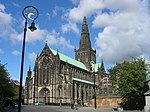Battle of Glasgow (1544)
1544 in ScotlandBattles involving ScotlandBattles of the Rough WooingConflicts in 1544History of Glasgow ... and 1 more
Source attribution

The Battle of Glasgow was fought on 16 March 1544, between Matthew Stewart, 4th Earl of Lennox and the Scottish Regent James Hamilton, 2nd Earl of Arran, and their adherents, during the minority of Mary, Queen of Scots. There was a second battle at Glasgow Muir in May 1544, known as the Battle of the Butts, between Arran and the Earl of Glencairn.
Excerpt from the Wikipedia article Battle of Glasgow (1544) (License: CC BY-SA 3.0, Authors, Images).Battle of Glasgow (1544)
Castle Street, Glasgow Townhead
Geographical coordinates (GPS) Address Website Nearby Places Show on map
Geographical coordinates (GPS)
| Latitude | Longitude |
|---|---|
| N 55.862972222222 ° | E -4.2344444444444 ° |
Address
Glasgow Cathedral (High Kirk of Glasgow;St Kentigern's;St Mungo's Cathedral)
Castle Street
G4 0QZ Glasgow, Townhead
Scotland, United Kingdom
Open on Google Maps










